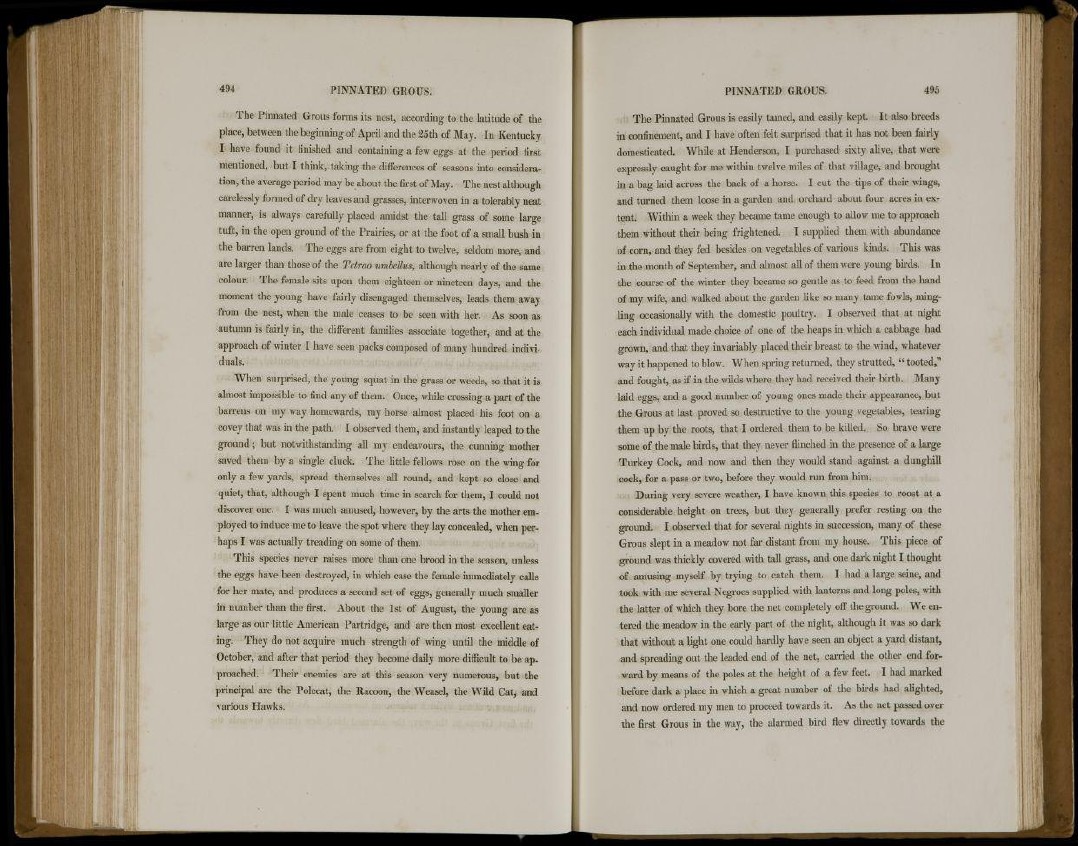
The Pinnated Grous forms its nest, according to the latitude of the
place, between the beginning of April and the 25th of May. In Kentucky
I have found it finished and containing a few eggs at the period first
mentioned, but I think, taking the differences of seasons into consideration,
the average period may be about the first of May. The nest although
carelessly formed of dry leaves and grasses, interwoven in a tolerably neat
manner, is always carefully placed amidst the tall grass of some large
tuft, in the open ground of the Prairies, or at the foot of a small bush in
the barren lands. The eggs are from eight to twelve, seldom more, and
are larger than those of the Tetrao umbellus, although nearly of the same
colour. The female sits upon them eighteen or nineteen days, and the
moment the young have fairly disengaged themselves, leads them away
from the nest, when the male ceases to be seen with her. As soon as
autumn is fairly in, the different families associate together, and at the
approach of winter I have seen packs composed of many hundred individuals.
When surprised, the young squat in the grass or weeds, so that it is
almost impossible to find any of them. Once, while crossing a part of the
barrens on my way homewards, my horse almost placed his foot on a
covey that was in the path. I observed them, and instantly leaped to the
ground; but notwithstanding all my endeavours, the cunning mother
saved them by a single cluck. The little fellows rose on the wing for
only a few yards, spread themselves all round, and kept so close and
quiet, that, although I spent much time in search for them, I could not
discover one. I was much amused, however, by the arts the mother employed
to induce me to leave the spot where they lay concealed, when perhaps
I was actually treading on some of them.
This species never raises more than one brood in the season, unless
the eggs have been destroyed, in which case the female immediately calls
for her mate, and produces a second set of eggs, generally much smaller
in number than the first. About the 1st of August, the young are as
large as our little American Partridge, and are then most excellent eating.
They do not acquire much strength of wing until the middle of
October, and after that period they become daily more difficult to be approached.
Their enemies are at this season very numerous, but the
principal are the Polecat, the Racoon, the Weasel, the Wild Cat, and
various Hawks.
The Pinnated Grous is easily tamed, and easily kept. It also breeds
in confinement, and I have often felt surprised that it has not been fairly
domesticated. While at Henderson, I purchased sixty alive, that were
expressly caught for me within twelve miles of that village, and brought
in a bag laid across the back of a horse. I cut the tips of their wings,
and turned them loose in a garden and orchard about four acres in extent.
Within a week they became tame enough to allow me to approach
them without their being frightened. I supplied them with abundance
of corn, and they fed besides on vegetables of various kinds. This was
in the month of September, and almost all of them were young birds. In
the course of the winter they became so gentle as to feed from the hand
of my wife, and walked about the garden like so many tame fowls, mingling
occasionally with the domestic poultry. I observed that at night
each individual made choice of one of the heaps in which a cabbage had
grown, and that they invariably placed their breast to the wind, whatever
way it happened to blow. When spring returned, they strutted, " tooted,"
and fought, as if in the wilds where they had received their birth. Many
laid eggs, and a good number of young ones made their appearance, but
the Grous at last proved so destructive to the young vegetables, tearing
them up by the roots, that I ordered them to be killed. So brave were
some of the male birds, that they never flinched in the presence of a large
Turkey Cock, and now and then they would stand against a dunghill
cock, for a pass or two, before they would run from him.
During very severe weather, I have known this species to roost at a
considerable height on trees, but they generally prefer resting on the
ground. I observed that for several nights in succession, many of these
Grous slept in a meadow not far distant from my house. This piece of
ground was thickly covered with tall grass, and one dark night I thought
of amusing myself by trying to catch them. I had a large seine, and
took with me several Negroes supplied with lanterns and long poles, with
the latter of which they bore the net completely off the ground. We entered
the meadow in the early part of the night, although it was so dark
that without a fight one could hardly have seen an object a yard distant,
and spreading out the leaded end of the net, carried the other end forward
by means of the poles at the height of a few feet. I had marked
before dark a place in which a great number of the birds had alighted,
and now ordered my men to proceed towards it. As the net passed over
the first Grous in the way, the alarmed bird flew directly towards the